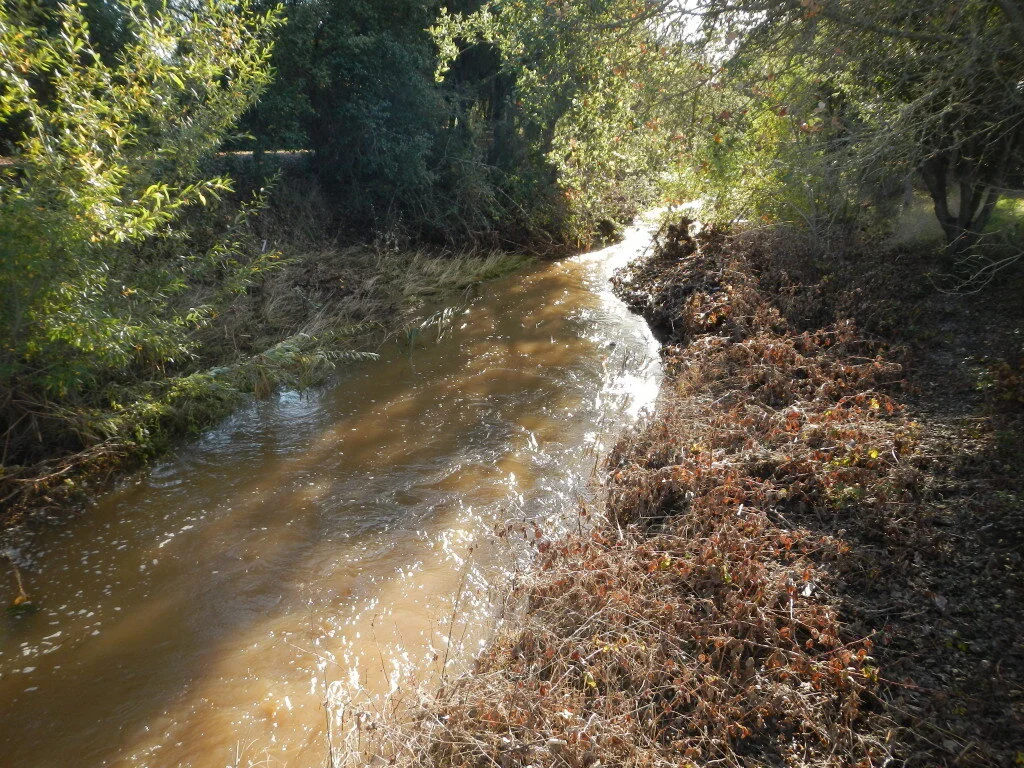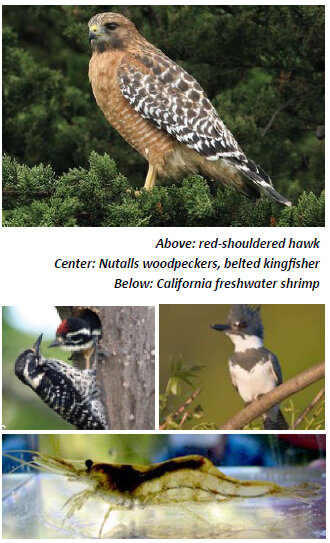Colgan Creek Wildlife
When a lush tree canopy has been restored to Colgan Creek, you can look for the presence of many birds.
In the lowest part of the trees, called the understory, look for a songbird called common yellowthroat; in the midstory, where foliage is thickest, look for the belted kingfisher; in a tree-trunk cavity, for a pair of nesting Nutalls woodpeckers; and in the topmost branches, the canopy, for osprey and red-shouldered hawk.
Creek = Corridor Animals need the creek to walk, feed, drink, flee or migrate. A creek should provide connectivity for animals—a safe and unbroken habitat pathway from one place to another. For animals, lush creeks are a corridor connecting them to food, water and cover as they hunt, hide and protect their off-spring. A fox would have a hard time hiding, hunting or raising kits along Santa Rosa Avenue.
Learn how land use and climate change are shifting the distribution of plants and other organisms in our region: Terrestrial Biodiversity and Climate Change Collaborative (TBC3) for the San Francisco Bay Area.
Native Fish
Most fish now in Colgan Creek are non-natives that can survive in the worst warm water conditions. Improving water quality in Colgan Creek—which flows into the Laguna de Santa Rosa—will benefit salmon and trout in the Laguna and Russian River.
Aquatic Insects
Adult Mayfly
When 3 key aquatic insects appear, then conditions are right for fish and other species whose life cycle depends on them: 1. mayflies, 2. caddisflies, and 3. stoneflies. Where we find these indicators species of insects thriving in Colgan Creek, we will also find good water quality and food for trout.
Native PlanTs
Plants, unless tossed about by wind or humans, don’t move much. We can walk right by them, as if blind to their existence. Plant blindness is a term coined in 1998 by scientists James Wandersee and Elizabeth Schussler to describe the human trait to not notice vegetation.
When people can’t even see a plant, they are less likely to understand what role it has in the ecosystem. Creek helpers might remind others that plants work hard. They filter water, prevent erosion, provide food, and sequester carbon dioxide, along with many other jobs. Trees create shade that cools the air and water for fish, and roots that filter water and keep the creek banks from washing away in storms. Trees bring birds back to the creek, and give cooling shade for people and other life forms escaping hot sun.
Right now Colgan Creek needs more trees and shrubs to create cooling shade and cover. We know that jays and other small animals stash acorns in the ground for eating later, and these acorns often sprout and become trees. But we want to plant more trees by intention than jays or squirrels can propagate accidentally.
Tree Farming Amateurs
Growing more trees is up to us amateurs. Amateur is French, from the Latin word for someone who loves—in this case someone who loves trees and wants to help them thrive. Sometimes amateurs can have superb results growing trees because they have their heart in their work, tending the plants that will one day become trees. A few healthy oaks can provide living space for well over 5,000 other species!
The simplest way to grow more trees and shrubs is to buy them. Less easy is propagation, which can be tricky, according to experts. When you succeed, do share your processes with others. We are all learning here!
Valley Oak (Quercus lobata ) California boasts 20 species of oak tree, but Colgan Creek has the right conditions for only a few, including blue oak, red oak, valley oak and the non-native cork oak. Valley oaks are the ones we want, since they thrive near creeks—and can live 600 years! You can purchase a seedling (see chart below) or plant acorns you gather from the tree or the ground.
Seedlings or Acorns
If you buy your seedling, care for it until it’s time to plant it in the ground. If you want to propagate a tree, start from an acorn. Take valley oak acorns from the tree in early fall, if they are turning brown and the cap twists off easily in your fingers. Or, pick acorns off the ground— only fresh-looking valley oak acorns, without cracks, mold or insect holes.
Twist off the caps and drop the acorns in a bucket of water, keeping the ones that sink. First put the keepers on a flat surface to dry, about half an hour, then place in a plastic bag in the fridge for a month. (Acorns that sprout in the fridge should be planted right away.) See Propagating Plants for more information.
Propagating Plants
Oak
Planting & Transplanting: You can plant acorns November through March, but ideally in November. To plant in the ground, dig a hole deeper than you need, refilling the hole with loosened soil to make it easier for roots to spread. Place the acorn on its side and cover with ½ – 1 inch of soil. Or, in a container of potting mix, place acorn on its side and cover with ½ – 1 inch of soil.
Transplant seedlings December through February, in damp but not frozen ground. Dig a hole deeper than your container, loosening the soil. Make sure the potting mix remains clinging to the roots, and that the top of the potting mix is exactly level with the ground.
Your Seedlings are Vulnerable: To guard them from hungry predators, try cages, closed on the top. In a 2 – 3 feet radius around the seedling, remove all weeds. Also, put down mulch so invading plants won’t take up all the available nutrients and moisture your tree needs to grow. Be sure to water, if necessary. Tend and guard your seedlings for at least 2 years. Does that seem like forever? If you can’t commit for that long, find someone who can, until the seedling is strong enough to fend for itself.
California Mugwort (Artemisia douglasiana)
This plant was used by the Pomo Indians for medicines and ritual practices. Mugwort grows up to 6 feet high and smells a bit like sage. Mugwort plants grow in close clumps resembling a shrub. The easiest way to propagate this plant is by dividing the roots or by separating the rooted rhizomes and transplanting them.
Pacific Rush (Juncus effusus)
Rushes grow close to the water in thick clumps suggestive of wire-thick grass. Like Mugwort, the Pacific Rush can be propagated by dividing mature plants or by transplanting rhizomes.
Buckeye (Aesculus californica)
Collect buckeye seeds in the fall, but use gloves, since the tree and seeds are toxic. Remove the fruit and drop seeds into a bucket of water to soak overnight, then drain. Saturate a mixture of 3 parts potting soil and 1 part sand, then drain half an hour.
Plant one seed (per container) leaving half the seed exposed and the pale part of the seed under soil. Cover with a fine layer of soil. Water infrequently, soaking as you did when planting the seeds. Buckeyes will germinate in about 3 weeks. Transplant in spring, spacing 20 feet or more apart. Tend buckeyes as you would oak seedlings, using cages with wire tops.
Willows
Willows “sprig” from cuttings. On Colgan Creek, red and yellow willow trees are wanted. Between October and December, choose straight branches between ¾ inch to 1 ½ inches in diameter. Cut to the main stem or to a bud which will later sprout. Cut at an angle and trim the top for a 3-foot cutting length (shorter will work also). Place angled cut 2 ½ feet into the ground, burying 2/3 of the cutting. Buds should point up.
Adapted from Groundwork, by Liza Prunuske




